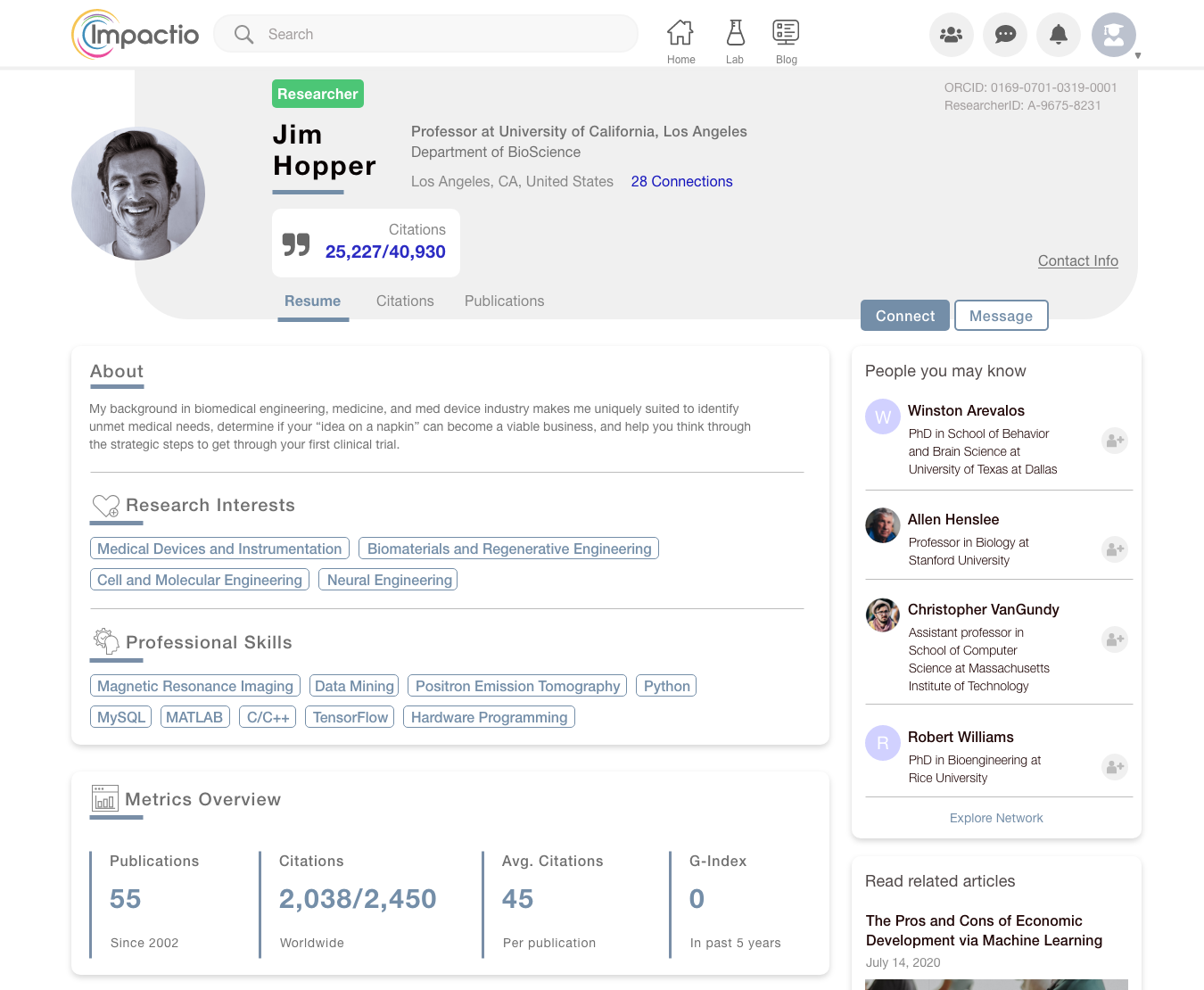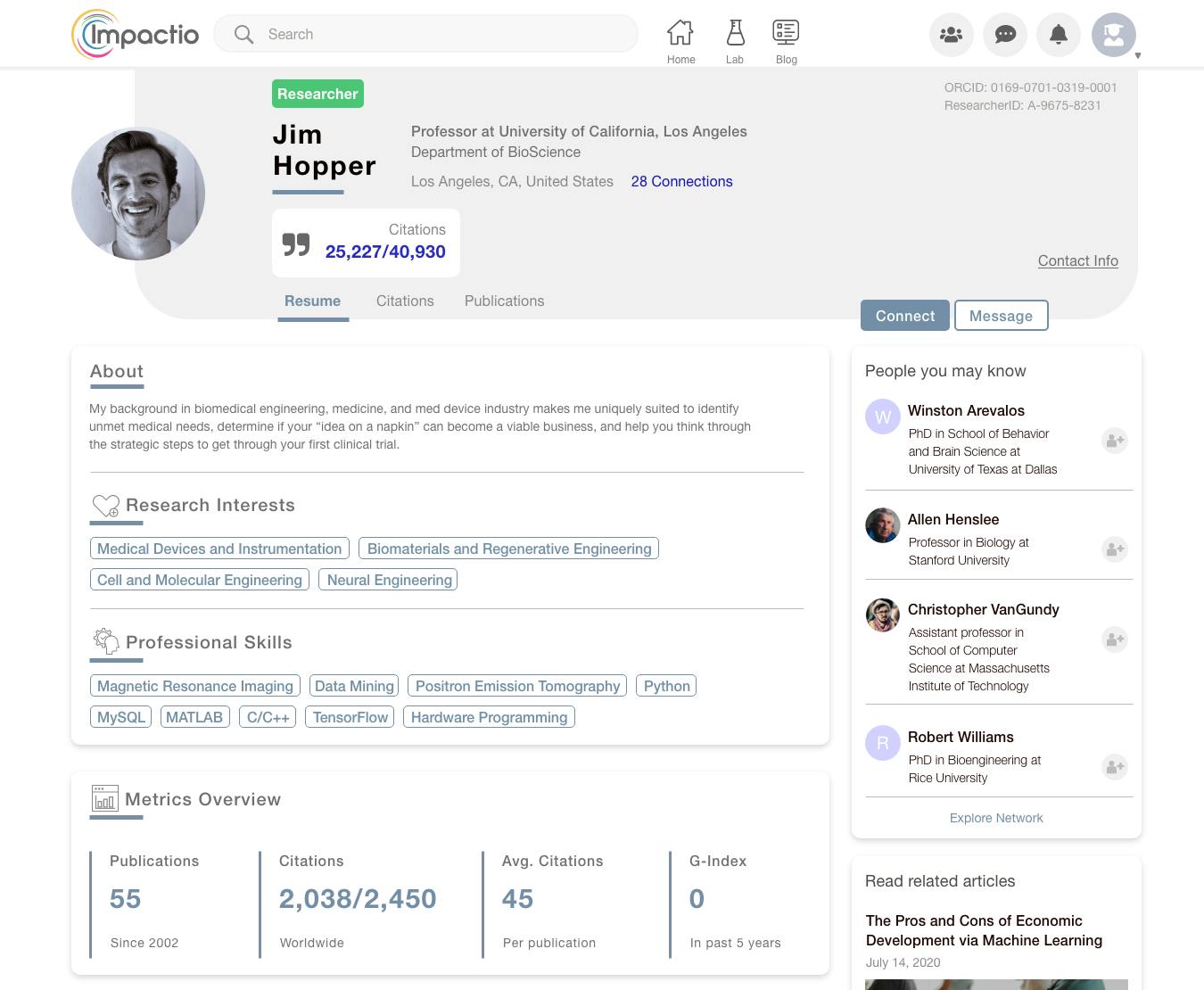An academic resume is more than the key to get an interview or land a job. It also reveals your efforts and impacts in your academic career. When people view your profile, you want to be well-prepared and bring out the best. Marketing yourself on a resume is not that hard, but how do I improve my academic resume/CV strength?
For scientists and researchers, demonstrating your academic impact analytics in a visualized citing map on an academic resume can definitely help! Also, quantifying academic work speaks more than words to help employers understand and evaluate your work.
Tips on how to develop your academic resume.
- Keep your academic resume easy to follow and well-organized.
- Show your relevant works and experience.
- Quantify your academic works.
- Demonstrate your impact through visual expressions.
1. Keep your academic CV easy to follow and well-organized
Make sure your academic resume is easy to read while providing numerous incredible achievements. To make your academic resume more attractive, you should arrange the information and display it with a consistent formatting layout.
On Impactio, you can generate your comprehensive academic resume with just one click. After you sign up as a research member, fill out the required information, and provide your Google Scholar Profile Link. Now, your profile is ready. Once you created your personal profile page, you can follow the instructions to edit your profile with your research and work experience, education, projects, prizes or awards, and so on.
In addition to the information on conventional resumes, Impactio's academic CV profiling service prepares thorough materials for researchers and scientists that enable them to present their talents and achievements better. Useful features include customized academic impact analytics, citing maps, and impact rankings of active research fields.
2. Show your relevant works and experience
To make your academic resume stand out, focus on showing your contributions toward a specific research field is necessary. A successful academic resume contains several essential elements and tells a great story of your academic career. However, developing an academic resume and including all the necessary materials can be challenging.
On Impactio, we break down all the essential components you need in an academic resume into blocks for education, research interests, research or work experience, reviews of other peoples' work, projects, presentations/talks, professional skills, prizes or awards, media publications, memberships, and patents. You can edit these blocks and customize your personal profile page by adding your own information to simply develop an effective academic resume. Additionally, you can export your profile as a PDF with one click.
3. Quantify your academic works
Exhibiting numbers is more potent than words. Quantifying your academic works can help you build a more persuasive academic resume. In the academic world, citation counts information is commonly regarded as an index of a person's academic impact.
However, citation counts information can not fully reflect the impact of a publication and its quality. That is to say, there is no tool to thoroughly quantify the academic impact and reveal a researcher's influence in the worldwide academic community.
To better justify the academic impact of a researcher, Impactio integrates commonly used metrics (including impact factor, SJR, Eigenfactor, and H5-index) to quantify a researcher's academic impact.
Moreover, Impactio calculates how many papers from a specific field cited any of your publications to present a researcher's contributions in the research field. By comparing to other authors' citation counts, the ranking percentile is also provided to indicate a researcher's citation ranking in a particular area of study.
4. Demonstrate your impact through visual expressions
Visual expressions can clearly illustrate a researcher's worldwide academic impact in your research fields. A great visual component is often more effective than words when conveying a message. Unfortunately, in the past, there was no tool to visualize academic impact information.
Now, Impactio provides multiple tools for researchers and scientists to present their academic impact better. For instance, researchers can obtain Citations Per Year graphs, Academic Ranking radial plots, and Citing maps on Impactio.
The Citations Per Year graph displays a researcher's citations by years. The Academic Ranking radial plot reveals a researcher's academic credits analytics by field lets you to discover the influence of research contributions in different disciplines. Most Importantly, the Citing map marks all the citing institutions around the world to disclose research impact. With Citing maps, researchers can gain a deeper insight into the worldwide influence of their research.
Within these tips, exhibiting numbers effectively with visualized information is essential for academic resumes. Currently, though, researchers can only acquire citation counts information through a website and get a citing map with incomplete information from another website. Plus, it is tedious to manually gather all the information together from different websites to display on academic resumes.
To this end, Impactio offers multiple tools to enable researchers to get their comprehensive citation analytics and visualized information on a single platform. You can easily get your citation data and visualized information to make your academic resume more convincing!
How do I get valuable academic analytics data on Impactio?
No worries, it's pretty simple. We will walk you through the steps you need to get your profile completed. To join the Impactio community, you can either sign up as a member with Google, Facebook account, or email. After you sign up, fill out the required information and provide your Google Scholar Profile Link. Then, your profile is ready. Once you created your personal profile page, you can follow the instructions to edit your profile.
Several blocks let you present work such as education, research interests, experience, projects, professional skills, and so on. Also, you can choose "import data from ResearchGate" to automatically complete your profile.
If you provided your Google Scholar Profile link, Impactio will automatically generate Impact Analytics blocks and offer all the data for you! In Impact Analytics blocks, Impactio provides citation data, academic ranking, and Citing map. Enjoy your academic analytics, and stay connected with talented researchers all over the world!
Academic Resume Example
Here is the academic resume example of components you might need to include in your academic CV. Wondering where these components fit into your academic CV? Customize each section on Impactio to craft a professional academic resume in minutes. Now let's dive in each section in more detail.
About
In this section, briefly introduce yourself and share your journey to help people get to know you.
Research Interests
Include your research interests to highlight your main research fields.
Education
List your educational background with degrees to indicate your academic training in your research areas. In general, provide your undergraduate and graduate institutions, including the degrees and dates of graduation.
Impact Analytics
As long as you provide your Google Scholar Profile link, Impactio will prepare impact analytics information for you. In this section, all the valuable and helpful information to make your academic resume unique and strong are included! Impactio provides Per Year Citation counts data with visualized graphs and academic impact rankings with radial plots. Impactio also includes a citing institution map that presents all the worldwide citing institutions to reveal a researcher's academic impact.
Publications
Like the Impact Analytics section, after you provide your Google Scholar Profile link, Impactio will automatically collect all of your publications and display these publications by categories including journals, conferences, books, and others for you. In addition, you can view the independent and total citation counts of each publication.
Research and Work Experience
List your research and work experience to show your research impact and contributions in academic fields.
Judge of the work of others
This section lets you list journals you review for and other related reviewing activities.
Projects
List the key projects you have involved in your academic career and describe those works to highlight your professional skills and experience for each project.
Presentations/Talks
In the Presentations/Talks section, list presentations you have given at conferences or other professional events. Include the titles of your talks and conference information.
Professional Skills
List relevant professional skills, including technical and non-technical skills, to perform your qualifications.
Prizes or Awards
Including prizes or awards on your academic resume is a great way to stand out from the crowd and show that your professional achievements are recognized in specific research areas.
Media Publications
Adding a note of media attention you have received is a plus for your CV. Focus on technical contributions you did during the events to demonstrate your talents.
Memberships, Licenses, or Certifications
If you are a member of a professional academic organization, include it on your resume. Make sure to list the organization's name, start/end years, and your title to describe your role. Also, list any licenses or certifications you have, if applicable.
Patent
List patent summary and descriptions to show your outstanding credentials and achievements.
Start to build your academic CV on Impactio now.
- https://www.impactio.com/researcher/qiming-zhou
- https://www.impactio.com/researcher/adrian-bejan
- https://www.impactio.com/researcher/stanley-nelson

